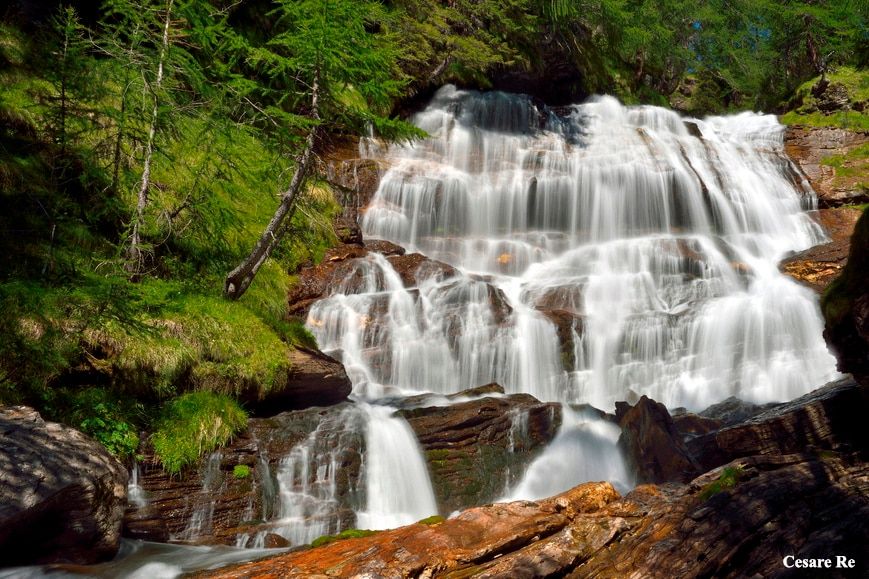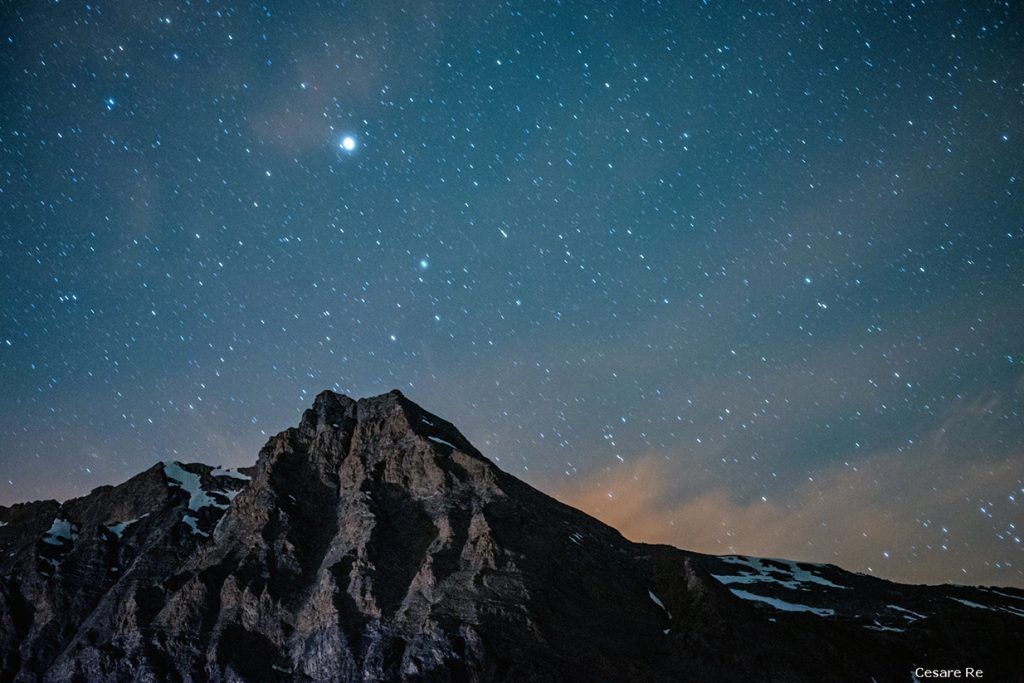Pizzo del Ton, in Valle Antrona, at dawn, with the moon resting on the summit.
Waiting for sunrise on Mont Blanc.
Monte Rosa, the Aosta Valley side, among the mists. Poor light which implies the need for a tripod.
From Passo Gavia, a photo that requires extended depth of field, to render the clarity of the rocks in the foreground and the peaks in the background.
No tripod, but long shutter speed to obtain the silky effect of water.
Night in the Gran Paradiso National Park, Punta Basei.
Macro of water drops. Indispensable tripod for any image of this type.
The tripod it is certainly useful for many photographic situations and for many subjects to avoid blur and micro blur. It is also advisable because it requires a series of movements and mechanical adjustments that force the photographer to concentrate and think slowly and unconsciously. It is also easier to concentrate on the framing and study a better composition for our photographs.
Is he unpleasant? There are many photographers, especially mountain photographers, who don’t like taking on the additional weight in their backpack. It is, however, one indispensable tool for some photographic genres, such as: photography in low light (sunrise, sunset), night photography, macro photography (almost always essential), use of long and heavy telephoto lenses, although in this case, thanks to the stabilizer, you can also avoid this and use makeshift supports , as we will see later or shoot freehand. To learn more about telephoto lenses and image stabilizer, I suggest taking a look at this chapter: wide angle and telephoto in the mountain landscape.

Blurred and micro blurred
If a photo is blurry you can see it immediately, with the naked eye, even on the small screen of the camera. It is an obvious error and cannot be remedied even with daring post-production operations. It gets trashed! The image affected by micro blur, on the other hand, is more subtle and evil. She apparently seems clear, especially if observed distractedly on camera. Once downloaded onto the computer and seen in a photo retouching program, however, you notice that she is not at all sharp, but she is clearly blurred.
Even printing on paper highlights defects, imperfections and micro blur. Even in this case, the image is trashed. Every time we take a photo, a series of vibrations are created that risk compromising the sharpness of the image. The flipping of the mirror of a reflex camera, the movement of the finger pressing the shutter button, the possible shaking of the photographer’s hand, long shutter speeds are causes of blur or micro blur. So how can we avoid blur and camera shake? Simple. Using a good tripod. Not easel! The easel is that of painters, the tripod is that of photographers!

And freehand?
The ideal would be to always use a tripod. Let’s be objective, though! If a photographer isn’t objective, who can be? On a trip to the mountains it becomes impossible, or almost impossible, to think about always taking photographs with a tripod. In many cases, among other things, we can do without it, because the light is abundant, because we are using a super wide-angle lens, light optics, or because we cannot take on the weight of the tripod (long trip, backpack weighed down by tools such as ice ax , rope, etc.).
In cases of low light, however, the tripod becomes indispensable, due to the shutter speeds which obviously become longer. To photograph a sunrise, a sunset, a starry sky, it becomes impossible to do without this photographic tool which is not an accessory at all, but an indispensable element for obtaining quality images. Even for macro photography, the tripod is crucial. In macro, in fact, you often shoot with small apertures, to have a high depth of field and, therefore, you will obtain long shutter speeds. Even using telephoto lenses, with some precautions and perhaps paying attention to the safety time and the “rule” of reciprocal focal length, it is possible to shoot freehand.

What if I raise the ISO?
Today, with modern digital cameras, it is also possible to raise the iso, to obtain a faster shutter speed and avoid, or reduce, the risk of blur or micro-blur. Be careful, however, as increasing the ISO value degrades image quality, especially increasing digital noise. It is therefore better to always shoot at low ISO, the native ones of the sensor, generally 64, 100, 200, depending on the model. However, in practice, the basic concept is valid: it is better to raise the ISO than take a blurry photo. The best thing, however, would always be to use a tripod.

What type of tripod?
Bad news: the more it weighs, the more stable it is. In general this is how it is. It is said, empirically, that the easel should weigh about 1.5 times what you intend to place on it. It’s a slightly dated rule, in reality, almost comparable to the historic (and beautiful) wooden ice axes of the pioneers of mountaineering. In reality today, fortunately, and for the health of the back and joints, there are also tripods that are a little lighter and quite stable, such as carbon ones; light and expensive, they are very stable, and ideal for outdoor activities and mountain excursions.
Then there are “hybrid” tripods, made of mixed materials, with parts in carbon, various alloys, aluminum and other curious types of materials. There are also stories of tripods made of aeronautical material which, in fact, cost the same as a supersonic plane! Without exaggeration, brands such as Gitzo, Manfrotto, Arca Swiss, for example, produce tripods of excellent quality and also in carbon, therefore rather light, not exactly cheap. It is also true that a good tripod lasts for many years of very intense use. Also keep in mind that you have to attach equipment to it which is certainly not cheap. We therefore need a safe support, certainly not one that could throw the camera off a cliff at the first gust of wind. Also recommended are brands such as Leofoto, Bernro, K&F Concept, Sirui even if, at the time of writing, some companies are inventing a new type.

The best tripods are made up of two parts: the legs and the head. The extendable legs also include a central column that can be raised further. The more legs and spine are extended, the more stability is lost. We therefore risk not only getting blurry photos, but also seeing our precious equipment fall to the ground. Tripod manufacturers indicate the sustainable weight for each head and tripod. If we mount heavy telephoto lenses (500 mm, 600 mm), it is necessary to use a particularly sturdy support and a special head, sufficiently stable and adequately sized. There are many types of heads, with different purposes, functions and names, depending on the brands. There are “ball heads”, joysticks, panoramic and three-way heads, etc. Professional heads have a (quick-attach) plate that attaches to your camera or lenses, allowing you to quickly attach them to the tripod head. Personally I recommend ball heads for photographing in the mountains. They are quite light and very versatile.

Tripods that allow you to lower the camera almost to ground level are excellent, useful for photographing flowers, or for shooting from a point of view close to the ground. I also mention the monopod, or a sort of extendable stick, with the possibility of mounting the camera above, in some cases also using a special head. Useful for photography of moving subjects, where it can help to obtain sharper photos.

And for long excursions or multi-day treks?
I suggest a lightweight, carbon tripod. By giving up the possibility of using a tool that extends a lot, the weight can be significantly reduced. After all, for most situations, there is no need to raise the camera much and you can always place the tripod on a rock or look for a high point if necessary. Let’s say that, in the mountains, there is no shortage of makeshift supports, such as rocks and logs. In desperate cases, I have also placed the camera backpack on a large stone, placing the camera on top. The shot will not be perfectly straight and level, but you can intervene in post production and straighten everything. It’s not exactly an orthodox system, but if you’re facing the dawn of your life, rather than taking a blurry photo or raising the ISO, this can be a winning solution.











